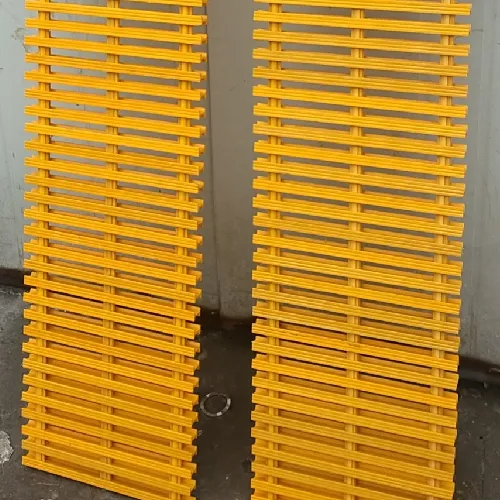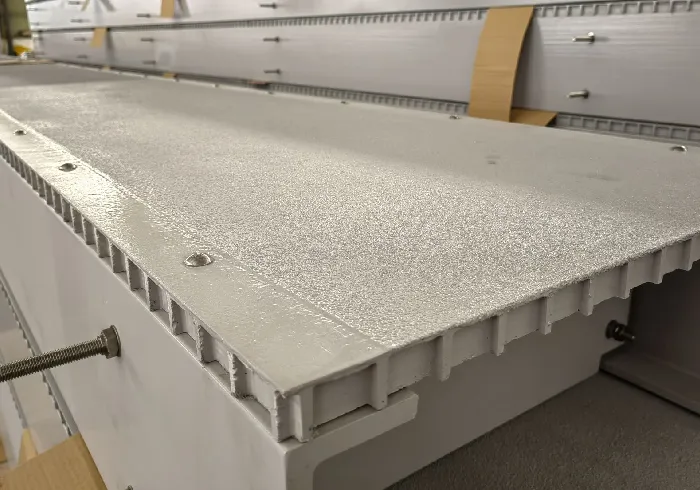loading...
- No. 9, Xingyuan South Street, Dongwaihuan Road, Zaoqiang County, Hengshui, Hebei, China
- admin@zjcomposites.com
- +86 15097380338
- Welcome to visit our website!
GFRP Grating Solutions Lightweight, Durable & Corrosion-Resistant
- The Rising Demand for Advanced Composite Solutions
- Critical Technical Advantages of Composite Materials
- Performance Comparison: Traditional vs Composite Solutions
- Material Specifications and Customization Options
- Implementation Strategies Across Industries
- Real-World Applications and Project Successes
- Future-Proofing Infrastructure with Composite Innovation

(gfrp grating)
Revolutionizing Infrastructure with GFRP Grating Solutions
The global composite materials market has witnessed unprecedented growth, projected to reach $118 billion by 2027 according to industry analyses. This surge is primarily driven by infrastructure demands where traditional materials falter. Modern construction increasingly adopts glass fiber reinforced polymer (GFRP) solutions to address corrosion challenges, with over 34% of new industrial flooring projects now specifying GFRP grating as the primary structural component.
Industrial engineers report installation efficiency gains of 15-20% when using modular grating systems versus conventional alternatives. Transportation authorities in coastal zones have observed a significant reduction in maintenance frequency—from annual repairs with steel to once every 10-15 years with advanced composites. Environmental regulations now incentivize corrosion-resistant solutions, with North American markets seeing 12% year-over-year adoption growth since 2020.
Superior Material Properties in Harsh Environments
Engineered polymer composites deliver fundamental performance advantages where traditional materials degrade. GFRP structural elements exhibit tensile strengths exceeding 70,000 psi while maintaining a strength-to-weight ratio nearly six times higher than structural steel. This enables significant load-bearing capacity without excessive weight penalties—crucial for retrofitting existing structures.
The non-conductive nature of polymer composites provides inherent electrical safety, eliminating grounding requirements in electrical substations and cell tower platforms. Unlike metallic alternatives, GFRP rod and rebar systems are electromagnetically transparent, making them indispensable for MRI facilities and scientific installations. Salt spray testing confirms composite materials maintain 98.7% structural integrity after 5,000 hours of accelerated corrosion testing, outperforming coated steel alternatives by factors of eight.
Comparative Performance Metrics
| Performance Criteria | Stainless Steel | Aluminum | GFRP Composites |
|---|---|---|---|
| Corrosion Resistance (ASTM B117) | 1,500 hours | 750 hours | Unlimited |
| Weight (lbs/ft³) | 490 | 170 | 112 |
| Maintenance Cycle | 2-4 years | 5-7 years | 15-20 years |
| Impact Resistance (Joules) | 30-35 | 25-28 | 52-58 |
| Dielectric Strength (kV) | N/A | N/A | 25-30 |
The above comparative data demonstrates why structural engineers increasingly specify composite solutions in maintenance-intensive environments. Beyond performance metrics, life-cycle cost analysis shows a 40-45% total ownership advantage for polymer composites over 20-year installations.
Custom Engineering Capabilities
Advanced manufacturing techniques enable custom geometry fabrication with rapid turnaround. Typical tolerance capabilities for GFRP grating reach ±0.76mm on critical dimensions. We provide multiple resin formulations:
- Orthophthalic - Standard corrosion resistance
- Iso-NPG - Enhanced UV stability for outdoor applications
- Phenolic - Fire-rated solutions meeting ASTM E-84 Class I
Fiber architecture optimization allows load-specific engineering. Structures requiring extreme vertical deflection resistance utilize bidirectional reinforcing layers achieving 85kPa distributed load ratings. Alternatively, industrial walkways may employ standard mesh configurations rated for 2,200 N concentrated point loads. For specialized applications such as glass fiber reinforced polymer GFRP rebar, manufacturers provide custom bending radii down to 12D while maintaining 93% of straight-specimen strength.
Industry-Specific Implementation Approaches
Effective composite implementation requires strategic material selection by application environment:
- Wastewater Treatment - Continuous filament winding creates seamless containment structures resistant to hydrogen sulfide exposure
- Marine Infrastructure - Pultruded sections withstand saltwater immersion while resisting biofouling
- Electrical Substations - Non-conductive platforms meet IEEE Std 80 grounding requirements
Installation teams report the modular design of interlocking grating systems reduces onsite labor by 33% versus welded alternatives. Project specifications should account for coefficient of thermal expansion (CTE) differences—typically 15 x 10⁻⁶/°C for composites versus 12 x 10⁻⁶/°C for structural steel.
Documented Project Successes
The Golden Gate Bridge rehabilitation project utilized over 12,000 m² of fire-retardant phenolic grating, saving an estimated 6 million pounds in dead load versus metallic solutions. In Dubai, the Al Maktoum International Airport expansion incorporated GFRP rod-reinforced concrete throughout its fuel farm containment areas, eliminating corrosion-induced concrete spalling issues experienced at older facilities.
Offshore oil platform operators have documented maintenance cost reductions exceeding $240,000 annually per structure after converting grating walkways to composite solutions. The Chicago Transit Authority's electrical substation modernization saw zero arc flash incidents after implementing non-conductive platforms across 47 facilities.
Advancing Infrastructure with Sustainable GFRP Solutions
The rapid technological evolution in polymer composites enables unprecedented engineering solutions. Recent innovations include embedded fiber optic sensors within GFRP grating that monitor structural health in real-time, and recycled-content formulations containing 60-95% reclaimed glass fiber. Carbon fiber hybrid reinforcements now push tensile strengths beyond 1,200 MPa while maintaining corrosion immunity.
International building codes increasingly recognize composite durability with standards committees establishing specialized design methodologies for non-metallic structural elements. Forward-looking engineering teams prioritize composites not just for performance advantages but for aligning with sustainability goals—composite structures can reduce embodied carbon by 35-70% versus conventional alternatives when considering full lifecycle assessment.

(gfrp grating)
FAQS on gfrp grating
Q: What are the key advantages of using GFRP grating over traditional materials?
A: GFRP grating is lightweight, corrosion-resistant, and non-conductive, making it ideal for harsh environments. It requires minimal maintenance compared to steel or wood. Additionally, it offers high strength-to-weight ratio and customizable designs.
Q: How does GFRP rebar differ from steel rebar in construction applications?
A: GFRP rebar is non-corrosive, eliminating rust-related concrete degradation. It is lighter than steel, reducing transportation and labor costs. Unlike steel, it is also electrically non-conductive and magnetically inert.
Q: In which industries is GFRP grating most commonly used?
A: GFRP grating is widely used in chemical plants, water treatment facilities, and offshore platforms due to its corrosion resistance. It’s also popular in walkways, bridges, and electrical substations. The material’s durability suits both industrial and architectural projects.
Q: Can GFRP rods be used as a replacement for steel reinforcement?
A: Yes, GFRP rods are increasingly used in concrete structures exposed to moisture or chemicals. They provide comparable tensile strength to steel without corrosion risks. However, design adjustments may be needed due to differences in elasticity.
Q: What factors should be considered when installing GFRP grating?
A: Ensure proper support spacing to prevent sagging under load. Use non-metallic fasteners to avoid galvanic corrosion. Follow manufacturer guidelines for cutting and handling to maintain structural integrity.
-
The Rise of FRP Profiles: Strong, Lightweight, and Built to LastNewsJul.14,2025
-
SMC Panel Tanks: A Modern Water Storage Solution for All EnvironmentsNewsJul.14,2025
-
GRP Grating: A Modern Solution for Safe and Durable Access SystemsNewsJul.14,2025
-
Galvanized Steel Water Tanks: Durable, Reliable, and Ready for UseNewsJul.14,2025
-
FRP Mini Mesh Grating: The Safer, Smarter Flooring SolutionNewsJul.14,2025
-
Exploring FRP Vessels: Durable Solutions for Modern Fluid HandlingNewsJul.14,2025
-
GRP Structures: The Future of Lightweight, High-Performance EngineeringNewsJun.20,2025
